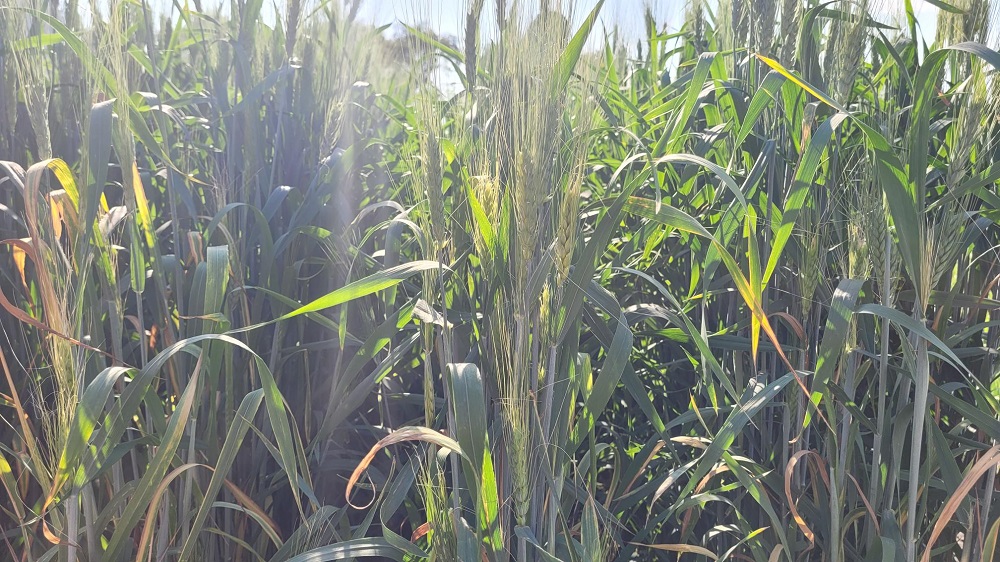The continuing dry conditions are affecting crop yield potential of Saskatchewan crops.
The Saskatchewan Crop Report says harvest has begun in the driest areas – the west central and southwest regions.
Rain fell in a few areas, ranging from 37-40 mm to just trace amounts. Producers are wanting substantial moisture as some areas have gone 30 days without precipitation.
Crops Specialist Matthew Struthers says for some farmers the rain is too little, too late.
“Very, very tough to see once again, and that crop yield potential that’s out there for many producers in the south, it’s set to (where) it doesn’t matter how much rain they get now they’re not going to see any benefit to it besides getting into the soils,” Struthers said. “There might be some seeded crops up north that could use a bit more moisture if they can hold on just a little bit longer through this heat, but overall it’ll be interesting to see where yield is at once we see more combines out there in the field.”
He says all season long top soil moisture conditions province-wide have been steadily declining. Cropland moisture is rated as 15 percent adequate, 48 percent short and 37 percent very short. Hay and pasture land topsoil moisture is rated as eight percent adequate, 43 percent short and 49 percent very short.
The report says crop quality ranges from very poor to good, with crops that have received rain showing higher crop conditions.
While the west-central and southwest regions have begun desiccating crops and combines are following suit, Struthers believes harvest for everyone else could begin soon.
Haying operations are almost complete with 5 percent standing, 13 percent cut and 82 percent baled or put up for silage.
Regarding crop damage, strong winds, drought stress, hail, extreme heat, grasshoppers and gophers took their toll on some crops, and many producers stopped applying pest control products.
A region-by-region breakdown is below:
Southeast
Extreme heat and drought continue to take their toll on crops in the region, many crops are showing signs of severe stress and reduced yield potential. Crops will be drying down rapidly due to the heat, meaning producers will start harvest in the next week or two and desiccation of lentil and pea crops is already underway across portions of the region. Producers with later seeded crops are hoping for some rain to ensure maximum seed fill. Some areas of the region did receive rain, but for many it will be too little and too late.
The Indian Head and Glenavon areas received the largest amounts of rain with 37 and 34 mm respectfully but overall, most of the region received insignificant amounts ranging from two to six mm. Cropland topsoil moisture is rated as 15 per cent adequate, 51 per cent short and 34 per cent very short. Hay and pasture land topsoil moisture is rated as eight per cent adequate, 34 per cent short and 58 per cent very short.
Haying is almost complete in the region with five per cent of the hay crop still standing and 77 per cent of it baled or put up for silage. Livestock producers will be working quickly to wrap up their haying operations since grain harvesting is right around the corner. In some areas of the region, hay yields are lower than last year but their quality is still high, with 81 per cent being rated as good and 19 per cent as fair. Those who are experiencing lower yields will be looking for other sources of feed.
Crop conditions vary within the region, with a majority in poor-to-good condition. Crops on heavier soil that have been retaining moisture look far better than any crop on lighter sandy soil.
Most of the crop damage this past week was due to drought stress, heat and damage caused by grasshoppers and gophers. Producers are busy finishing up haying, conducting yield assessments and getting their harvest plans sorted out.
Southwest
Another hot, dry week has crops across the region drying down rapidly and some producers have started to harvest while others are applying desiccants. Producers are predicting well below average yields for many of their fields due to limited precipitation all season long. There were light showers in localized areas in the past few weeks, the crops are holding on and producers hope they will have higher yield potentials.
Livestock producers have completed their haying operations with 84 per cent of the hay crop now baled or put into silage with an additional 12 per cent cut and waiting to be baled. Hay quality is rated as 53 per cent good and 47 per cent fair. Hay yields across the region are far lower than the regional and provincial averages.
Producers are looking for alternative feed sources and there are increasing reports of the likeliness to sell portions of cattle herds to lessen the burden on winter feed supplies.
There were small showers throughout the region but this did not impact crops or soil due to the heat. Cropland topsoil moisture is rated as three per cent adequate, 40 per cent short and 57 per cent very short. Hay and pasture land topsoil moisture is rated as two per cent adequate, 39 per cent short and 59 per cent very short.
The majority of crops in the southwest region are in very poor-to-fair condition with little being rated as good. The region did not receive rain at crucial times during the growing season, leaving crops thin and stunted. Some producers in the region have begun to harvest pulse crops and will be harvesting cereal crops in the coming weeks. Failed crops will likely be sought by livestock producers looking for feed options.
Most of the crop damage this past week was due to drought stress, strong winds, heat and grasshoppers. Producers are busy finishing up haying, conducting yield assessments, harvesting or getting equipment and bins ready for harvest.
East-Central
Parts of the region had a very dry July and crops have declined from heat and drought stress. Producers are hoping for showers soon to help maintain their current yield potential. In areas where precipitation has been more regular, crops are holding on but signs of stress from the extreme weather of the past few weeks are starting to show.
Rainfall was a welcomed sight in the region, helping cereals fill their heads and canola and pulse crops fill their pods as harvest nears. Some crops received the rain too late, which will likely result in disappointing yields. Cropland topsoil moisture is rated as 18 per cent adequate, 47 per cent short and 35 per cent very short. Hay and pasture land topsoil moisture is rated as 12 per cent adequate, 44 per cent short and 44 per cent very short.
Livestock producers across the region have 83 per cent of the hay crop baled or put into silage with another seven per cent cut and waiting to be baled or put into silage. Hay quality is currently rated as 13 per cent excellent, 57 per cent good, 26 per cent fair and four per cent poor.
The majority of the crop in the region is rated as being in poor to good condition, the poorer rated crops are in the western half of the region where rain has been less frequent.
Most of the crop damage this past week was due to heat and drought stress, wind and grasshoppers. Producers are beginning to prep their equipment for harvest and will be desiccating in the coming week.
West-Central
Small, isolated showers dotted the region this week, but it was little benefit to the crop due to it being far too late in the season. Crops in the region held on through the heat and drought of the growing season, but it has now dried down. Some producers have started harvesting lentils and cereals, such as wheat and barley, are not far behind. Yields will be below average for the region and many producers indicate they will be cutting extremely poor fields for livestock feed. For those producers who received small, localized rains over the growing season, yield potential appears to be closer to the regional long-term average.
The dry weather has allowed haying progress to advance in the region with 92 per cent of the hay crop now baled or put into silage and the remaining seven per cent cut and waiting to be baled or put into silage. Hay quality is rated as 68 per cent good and 32 per cent fair. Hay yield is much lower than average for the region and many producers are worried about winter feed supplies, indicating they will be seeking alternative feed sources to avoid reducing herd sizes.
Cropland topsoil moisture is rated as 16 per cent adequate, 45 per cent short and 39 per cent very short. Hay and pasture land topsoil moisture is rated as six per cent adequate, 35 per cent short and 59 per cent very short.
The majority of crops in the west-central region are in very poor-to-good condition. Some producers are preparing for harvest and have desiccated pulse crops such as lentils and field peas.
Most of the crop damage this past week was due to drought, wind, heat and grasshoppers. Some crops in the region have been completely written off by the combination of drought and grasshopper damage.
Northeast
Crops vary greatly across the region, some look great due to timely rains while others are in poor condition. More moisture is needed to fill pods and heads and producers are hoping for a some more rainshowers in the coming weeks. The heat has caused crops in the drier parts of the region to begin to rapidly dry down creating an earlier than normal harvest for some producers.
The hot dry week helped haying operations and livestock producers currently have 81 per cent of the hay baled or put into silage. An additional 12 per cent is cut and ready for baling. Hay quality is currently rated as 14 per cent excellent, 71 per cent good and 15 per cent fair. Cattle producers have indicated that without significant rain there will likely not be a second cut of hay.
Cropland topsoil moisture is rated as 25 per cent adequate, 67 per cent short and nine per cent very short. Hay and pasture land is rated as 16 per cent adequate, 69 per cent short, 15 per cent very short.
The majority of crops are in poor-to-good condition. Crops in the areas of the region that received rain look good, but as hot days continue and moisture becomes sparse, crops have experience yield reducing stress such as heat blasting of flower petals.
Most of the crop damage this past week was from heat, insects and the wind. Producers have not started harvesting but have begun to prep equipment to be ready for when their crop dries down in the coming weeks.
Northwest
Crops that received rain are managing to hold on, but crops that did not receive much needed rain are rapidly drying down. Some producers are noticing that pods and heads are not filling and without rain soon, the crops in the dry areas of the region will experience drops in their yield potential. Some report that if the heat continues, they will need a inch of rain a week to get their crop to harvest.
Haying has been progressing well in the region and livestock producers currently have 81 per cent of the hay baled or put into silage. An additional 12 per cent is cut and ready for baling. Hay quality is currently rated as 67 per cent good and 33 per cent fair. Livestock producers are hoping for a large precipitation event in order to make a second cut of hay in September.
Cropland topsoil moisture is rated as 32 per cent adequate, 53 per cent short and 16 per cent very short. Hay and pasture land is rated as 15 per cent adequate, 55 per cent short and 30 per cent very short.
Most of the crop damage this past week was due to heat stress, grasshoppers and drought. Producers are beginning to apply desiccants and get their harvest equipment ready.








